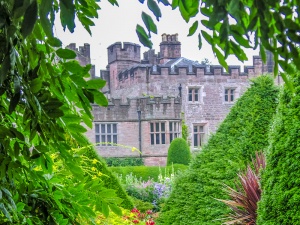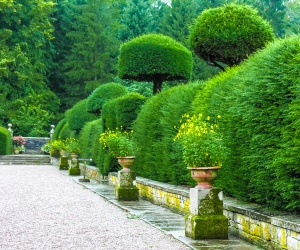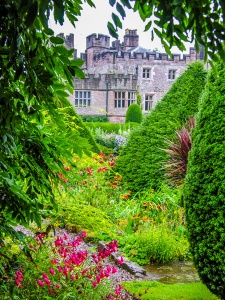
A lovely historic house in a quiet north Cumbrian village, Hutton-in-the-Forest boasts a Stuart limestone facade, which is dwarfed by two towers, one a surviving pele tower from the 14th century, the other a false Gothic giant constructed in the 19th century.
The interior is a mix of Regency and Victorian rooms, including original William Morris wallpaper. The same family has been here since 1605. The grounds of Hutton-in-the-Forest contain a classical array of terraces, topiary, walled garden, and dovecote. Fine specimen trees make a woodland stroll a pleasure.
History
The story of the building of Hutton-in-the-Forest covers over 500 years. The oldest part of the house is the Pele Tower, built around 1350. Pele towers are a feature of northern English architecture. They are defensible tower houses, a reminder of the often violent life could be close to the Scottish border. The Pele would originally have been surrounded by a moat, but this has long since disappeared.

The Families of Hutton
It is extraordinary to think that over the course of seven hundred years only two families have own Hutton-in-the-Forest. The first was the de Hoton family. Thomas de Hoton was Crown Forester to Edward I, at the time when Hutton was part of the Royal Forest of Inglewood. In the late 13th century Inglewood was the second largest royal forest in the country, so Hoton's appointment indicates that he was considered a man of no little importance.
The de Hoton family were resident at Hutton until 1605 when the estate was purchased by Richard Fletcher of Cockermouth. The Fletchers have owned the house ever since, though the name of the family has changed in the interval to Vane Fletcher, and then to its current permutation, Fletcher Vane.
It was the first of the Fletchers, Richard, who began the transformation of Hutton from a fortified manor into its current status as a comfortable country house estate. Hutton's darkest hour came in 1745 when the house was occupied by supporters of Bonnie Prince Charlie in the Stuart attempt to seize the throne.

The House
Hutton is built in an L shape, with the main house block forming two sides of a walled courtyard. The frontage is largely 17th century, of classical design, joined sympathetically to the Pele Tower. The interior is a wonderful mix of the old and the new-by-comparison. The stone vaulting of the Pele Tower gives way to Victorian Gothic and William Morris wallpaper. There is beautiful wooden panelling, largely Jacobean, and lovely period furniture.
The Gardens
Hutton is surrounded by woodlands; it truly is 'in-the-Forest'. The land falls way on two sides to landscaped gardens of lawn and topiary. A formal terrace leads behind the house to a lovely rhododendron garden designed in 1870 by Anthony Salvin under the patronage of Lady Vane.
There is a Walled Garden area given to riotous colour in season, and woodland walks. In the garden is a 17th-century dovecot holding over 400 nesting boxes. In the grounds is St James church, a deceptively simple church which has existed here since at least the 13th century. The current building is largely 18th century, and it houses an 11th-century Viking cross.
Our visit
We had the misfortune to visit Hutton-in-the-Forest on a blustery, grey day, but it was still a pleasure. The staff were exceedingly helpful and went out of their way to make our visit enjoyable. There were quizzes for the children, stewards to answer questions in most rooms of the house, and they even had a very handy brolly to loan us for our walk around the garden.
One pleasing touch was that there was a large children's trampoline in a corner of the private lawn area, a reminder that Hutton is very much a family home, not a museum piece. All in all, we had a very enjoyable visit, and would certainly go back again, though, hopefully in nicer weather!
17th-century dovecot
17th-century Gallery and East Front
About Hutton in the Forest
Address: Penrith,
Lake District,
Cumbria,
England, CA11 9TH
Attraction Type: Historic House
Location: 6 m NW Penrith, on B5305
Website: Hutton in the Forest
Email: info@hutton-in-the-forest.co.uk
Historic Houses Association
Location
map
OS: NY460 358
Photo Credit: David Ross and Britain Express
HERITAGE
 We've 'tagged' this attraction information to help you find related historic attractions and learn more about major time periods mentioned.
We've 'tagged' this attraction information to help you find related historic attractions and learn more about major time periods mentioned.
Historic Time Periods:
Find other attractions tagged with:
14th century (Time Period) - 19th century (Time Period) - Regency (Architecture) - Stuart (Time Period) -
NEARBY HISTORIC ATTRACTIONS
Heritage Rated from 1- 5 (low to exceptional) on historic interest
Penrith, St Andrew's Church - 4.6 miles (Historic Church) ![]()
Penrith Castle - 5 miles (Castle) ![]()
Dalemain - 5.6 miles (Historic House) ![]()
Dacre, St Andrews Church - 5.7 miles (Historic Church) ![]()
Mayburgh Henge - 5.8 miles (Prehistoric Site) ![]()
King Arthur's Round Table - 6.1 miles (Prehistoric Site) ![]()
Brougham Hall - 6.2 miles (Historic Building) ![]()
Brougham Castle - 6.4 miles (Castle) ![]()




